Cradle Mountain, camping in the snow.
If you have been following this blog, you will know that I have been trying to get out snow camping almost every weekend since I returned from Europe, but that something has always come up to prevent it. At last this weekend I got my wish. Angela had time free and wanted an adventure; snow was predicted: we were off. Initially we were (we thought) going to climb Blue Peaks and be on the Western Tiers, but road access problems meant that we had to choose the Cradle area in order to get both an open road and snow. I wasn’t sad. I love this place, and don’t always need to be somewhere new.
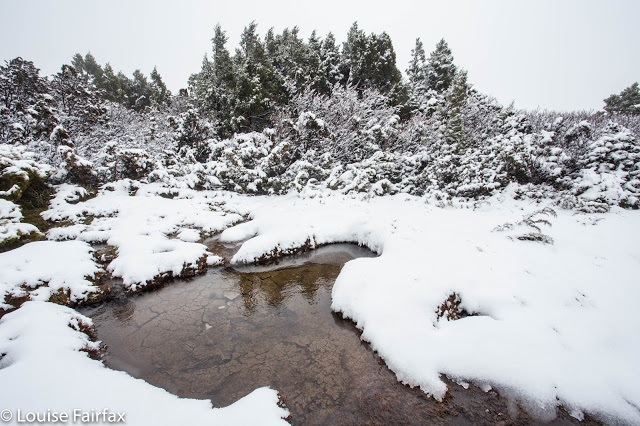
We were both feeling a bit out of practice at Tassie-style snow work, so I also enjoyed being in an area that offered us plenty of dramatic snow and yet was only a couple of hours from the lodge, so somehow that felt less remote if anything went wrong. It was good to have a chance to refine our methodology and test some of our new gear here before committing ourselves to the really deep wild wilderness. Mind you, during the night, with the wind howling and the tent making explosive whiplash noises, I didn’t feel so terribly secure, and kept wondering if I’d survive if the tent broke in one of these furious gusts. Plenty of people have died within five kilometres of Cradle, so it didn’t feel particularly wussy during the night.
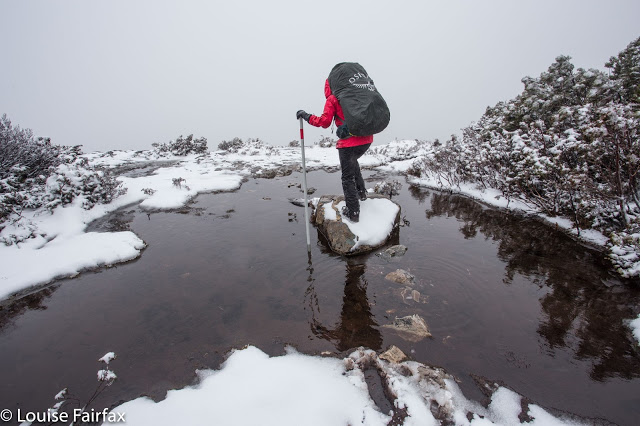
I am “naturelover”, so it goes without saying that I love nature: this does not mean some National Parks attenuated idea of nature, some metre-wide levelled out highway through what is dubbed wilderness for the sake of city tourists, but which is tamed with infrastructure to defang it for timid human toleration. I am not against the existence of such tracks – everyone begins somewhere, and my love of extended bushwalking began with the Overland Track, and it serves a need either as a beginning point, or even an ultimate achievement for many people. However, I think if we really want to meet nature in its supreme form, we need to expose ourselves to some of its less “pretty” and comfortable aspects. A snow storm in winter is one such.
Robert Macfarlane in The Wild Places, a book searching for wild locations in Britain, spends a night in midwinter on a Lake District mountain exposing himself to the fury of a storm in order to experience and appreciate nature’s unleashed force. When I read his book (which I loved) I felt so sorry for the people of the British Isles, that there were so few places where they could experience the might of undiminished nature. We are somewhat spoiled in Tasmania to have reasonably easy access to abundant places that satisfy this longing – but we need to be wary. People who only see nature as the means for making money and who wish to thus subject nature to their concept of what tourists want and who are willing to sacrifice what they neither know nor understand to the great god of dollar are encroaching on the wildness and wilderness we have left and are chomping bits out of it at an alarming rate.
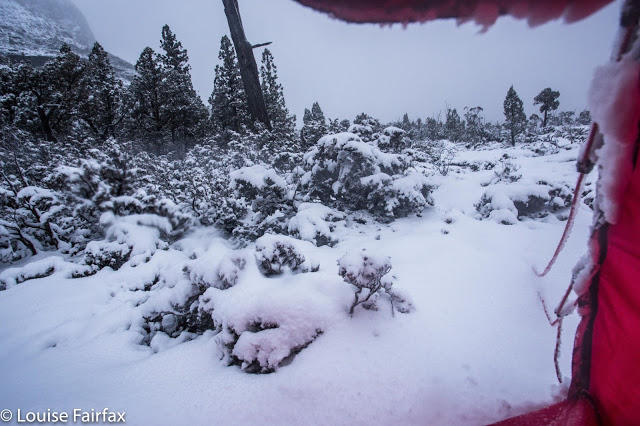
Many, many Tasmanians mourn the loss of the access to wilderness that we used to enjoy in our own national parks as our old freedoms are removed with each new development, for the most part brought in to allow better management of visiting tourists rather than any motive of caring for the land. Our love of this land is being ignored. Our attachment to the land, our sense of spirituality that comes from being in infinite space and beauty, and our culture of camping and walking in it are treated as nugatory. Of course the tourist industry has myriad excellent features, but that does not mean we allow it to run out of control so that the only wild thing left in our state is that government department. Like alcohol, tourism should be used in moderation. I would love to live in a land where values other than money ruled our ethos and regulations. I fear this worship of money above all other values will ultimately bring about the collapse of western civilisation as we know it, for it is fast running out of control in a destructive solipsistic spiral. The object so valued because it can bring so much can also be the object of demise when not controlled.
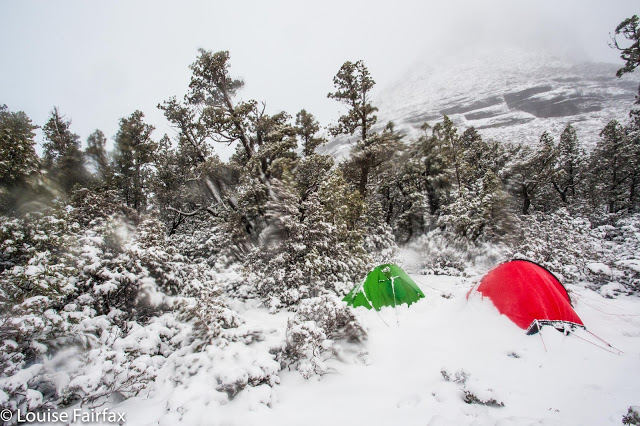
I thought of Robert Macfarlane during the night of not-all-that-much sleep, and pondered such issues. We cannot respect nature if we don’t know what it is, and if we fail to respect it, we will harm this beautiful earth beyond repair.
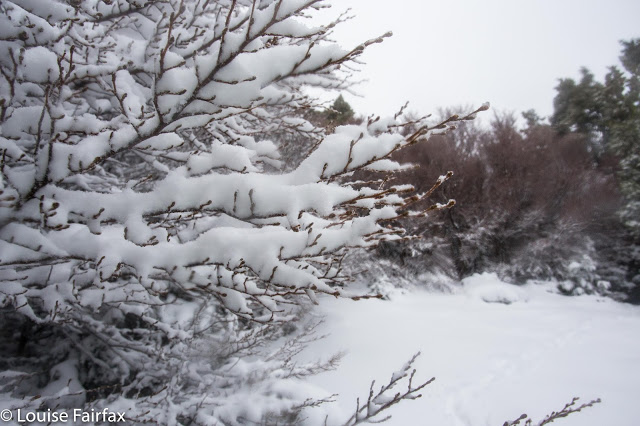
For those who have not tried snow camping, but who are already thinking they want to take this step, I will tell you what we wore to bed. One size does not fit all. We are both small, lean females who feel the cold. Our needs will probably not be felt by those with more padding, and will not suffice those with less. This is what I had on to survive the night, and Angela’s story is similar. On my head I had a silk balaclava, an icebreaker buff and the hood of my Arcteryx jacket (as well as the hood of my bag). On my upper body, I had an icebreaker singlet, a long-sleeved thermal top, an icebreaker T-shirt and a cosy Arcteryx jacket, as well as the warmth from my sea-to-summit SpIII goosedown bag (850 loft, 400g fill). My hands were warmed by possum gloves. On my legs, I had thermal longs (over woollen knickers), orienteering pants, another pair of icebreaker wooden long tights and the bag. On my feet I had woolly socks (two pairs would have been nice). Over all of that, I had an SOL bivvy bag (which adds five degrees to what you can tolerate), and over that, my trusty tent. The temperature difference between the other side of that flimsy wall and the protected inside was easy to note. I also had my Goretex jacket spread over my feet area. In my pillow bag, I had another jacket should I need it, and another thermal, but I felt fine. We both used four-season mats. I also had a carpet underlay.
My knees were sometimes a little cold during the night, but as long as the temperature didn’t drop any further, I was fine as I was, and didn’t pull out my reserve gear. I was absolutely definite that I was NOT getting out of that bag to go to the toilet, which I unfortunately needed to do from about 9 p.m. until 7 a.m., but there are some bodily needs that just have to be taught their place. Angela likewise refused her body this request.
Dismantling the tents was probably the least enjoyable part of our excursion, but once we were underway walking again, the pain in our hands soon eased, and I was left wondering exactly how slippery the steep part of the Face Track descent would be. We chose that route as it is the least exposed in our opinion, but still could be challenging in icy conditions where the steel chain is frozen over and the land drops dramatically away over rock that has few vertical holds. We were both carrying minispikes just in case, but, on this occasion, the powdery snow had not melted to make slippery ice, so all was well. And meanwhile, the sight of gums drooping with icy mantels, of filigree branchlets capped in a delicate white covering, of wombats caught unawares whilst burrowing in snow all thrilled me as I scanned the landscape for signs of where a track might be when not masquerading incognito as bland white wilderness. The powdery snow made a delicate sort of squeaking sound as our feet compressed its mass. I wish I could have taken more photos, but I was far too cold, and was having trouble with my camera lens clouding over in these conditions.
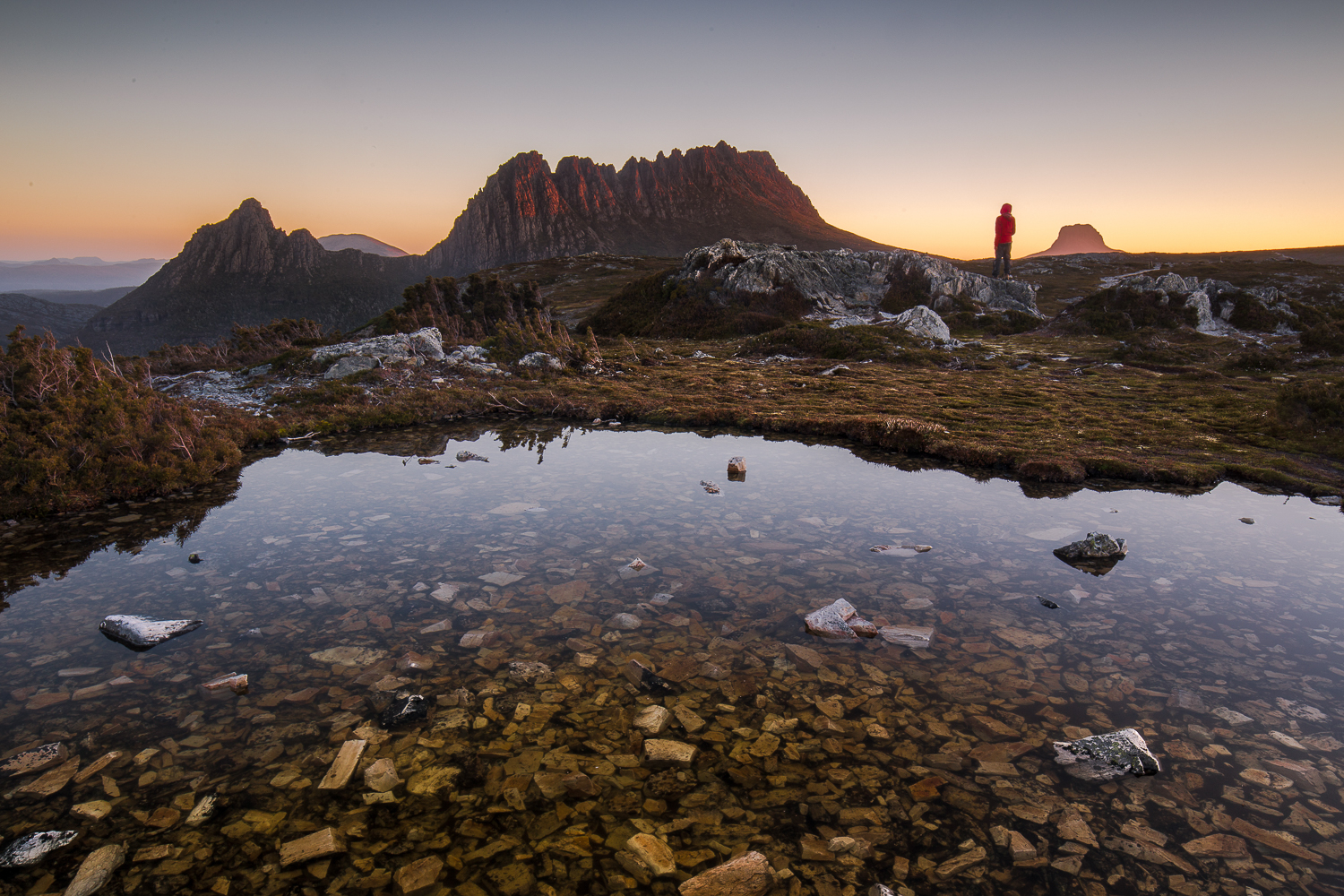
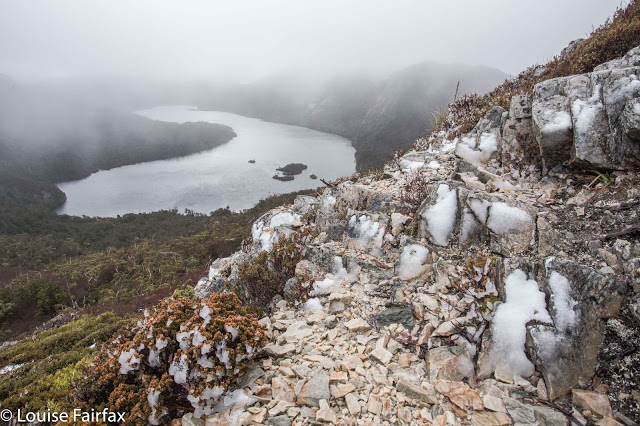





Beautiful photos!!! I love long walks in nature. This summer has been difficult here in Montreal, Canada, though, because the heat and humidity has been very high so in order to stay safe I have been taking my walks in air conditioned malls. I much prefer my nature walks and look forward to the cooler days!
Beautiful photos!!! I love long walks in nature. This summer has been difficult here in Montreal, Canada, though, because the heat and humidity has been very high so in order to stay safe I have been taking my walks in air conditioned malls. I much prefer my nature walks and look forward to the cooler days!
Hi Linda, Thanks for commenting. I'm glad my winter posts can give you some vicarious exercise and outdoor time in nature while you wait for cooler weather. Have fun. Cheers,
Louise
What type of tent do you use Louise?
Hi Russ, Thanks for the question. I use a Hilleberg akto; Angela, a Macpac Microlight. Hers is cheaper; mine is much roomier , although the same weight, and mine gives a way better view out the window. Both tents are pretty bombproof, and excellent for these conditions. Angela found that the snow weighed her tent down so she had very little room next morning. If using a microlight, you need to position your pack inside, up against the wall, to prevent this from being quite so bad. It can push the wall out for you. I did that in snow before I bought my Hilleberg.